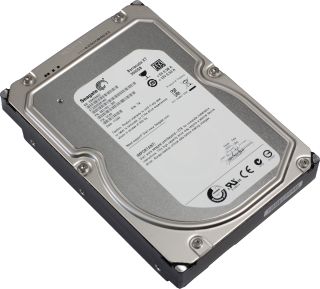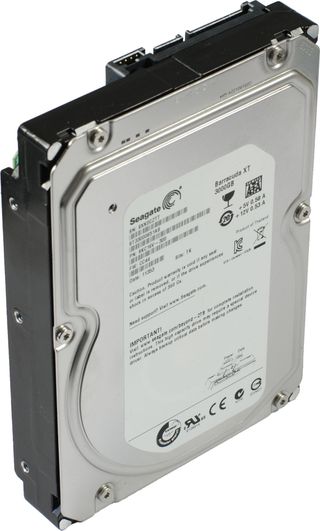Four 3 TB Hard Drives, Tested And Reviewed
Hard drives able to hold 3 TB of data need to be considered carefully because they might not always work as expected. This round-up of four high-capacity disks compares products from Hitachi, Seagate, and Western Digital, then covers their caveats.
Seagate Barracuda XT (ST33000651AS)

In addition to its impressive 3 TB capacity, the Seagate Barracuda XT holds its own against the rest of the competition when it comes to performance as well. Just like the Hitachi Deskstar 7K3000, Seagate's drive is equipped with a 64 MB cache, a 6 Gb/s SATA interface, and a spindle speed of 7200 RPM. Besides the 3 TB flagship model (ST33000651AS), Seagate also offers the Barracuda XT with four platters instead of five, resulting in a reduced capacity of 2 TB (ST32000641AS).
With its high speed, Seagate suggests that the Barracuda XT is particularly well-suited for high-performance PC gaming systems, HD video editing, desktop RAID arrays, and home/small business servers. Use that word server carefully, though. This product was primarily designed for desktop use, and servers have different requirements, often starting with the interface all four of these disks employ.

Performance
This drive has the highest sequential read rate, with an average of nearly 120 MB/s. However, the Hitachi Deskstar 7K3000 is closely behind at 118 MB/s. Thanks to its impressive speed, the Seagate drive also does well in tasks that require quick access times, such as application launching. In typical server workloads, the Seagate Barracuda does not perform up to the level suggested by its manufacturer. In the Iometer benchmark, which assesses typical Web server, workstation, and database performance, even the supposedly slower drives from Hitachi and Western Digital perform better. That's a clear sign that the Barracuda XT is not optimized for such tasks. Then again, we already knew that, right?
When it comes to saving power, Seagate overtakes Hitachi and its Deskstar 7K3000. While Hitachi's device uses up to 9.2 W, depending on the benchmark, the Barracuda XT uses a maximum of 7.7 W.


Stay on the Cutting Edge
Join the experts who read Tom's Hardware for the inside track on enthusiast PC tech news — and have for over 25 years. We'll send breaking news and in-depth reviews of CPUs, GPUs, AI, maker hardware and more straight to your inbox.
Current page: Seagate Barracuda XT (ST33000651AS)
Prev Page Hitachi Deskstar 5K3000 (HDS5C3030ALA630) And Deskstar 7K3000 (HDS723030ALA640) Next Page Western Digital Caviar Green (WD30EZRS)-
agnickolov ReplyThree terabyte hard drives remain premium products, not only because they're best handled by enthusiasts who know what they're doing, but also because they're the largest disks available and you always seem to pay more for the largest, fastest, coolest...well, you know the drill.
Well, that's no longer the case:
http://www.tomshardware.com/news/GoFlex-Desk-4TB-3.5-inch-industrial-design-USB-3.0,13371.html
-
vdr369 Seagate barracuda is pulling my heart with it's performance, but punching my pocket with it's price,Reply -
salb99 the hitachi 5k3000 at max throughput uses less power than at idle, is it correct? also, video power consumptions here are the same as idle for all drives.Reply -
dww I don't see the point of 3 TB drives. Too big to use in most current systems, but too small to be a useful gain over 2 TB for those that CAN handle larger sizes. At present they're also too expensive, and once 4 TB drives come out in volume they'll be superseded. So I guess they're just a short term stopgap.Reply -
excidium Graph labels for the 7K3000 are incorrect ( 5400RPM ) on page:Reply
Benchmark Results: Throughput And Interface Bandwidth
Haven't finished reading the rest of the article. -
WD30EZRS recommended for NAS?Reply
how about TLER ? and the issue with frequent head parking ? Though the later is correctable with wdidle3.exe..
Considering each green drive might have different rotation speed are you sure about your NAS recommendation? -
monkeysweat i know 2TB is cheaper per GB,, however i only got 4 HDD slots in my case,, and 3 are in use already,, 1.5, 2.0 & 2.5 TB model drives + 1 SSD tucked under my card reader,, either i gotta spend more on a new case + drive or just spend a little more on a nice drive...Reply -
chesteracorgi With 2 Samsung 2.0 TB F4 Ecogreen (SATA 3.0 & 32 MB cache) and 2 1.5 TB Seagate Barracuda Green (SATA 6.0 & 64 MB cache) drives installed in my home server, it is my experience that HDDs are no better off on SATA 6.0 than on SATA 3.0. If you are looking for performance then look for a faster rpm rate: the 640 GB WD Caviar Black (SATA 6.0 & 64 MB cache) kills all of the above in speed. However, none of these HDDs can touch an older generation SSD like the Crucial C300 (128 GB).Reply
The most important characteristic of the HDDs is reliability. So far, since 3/11, all of the HDDs have proven reliable, while the SSD had to be RMA'd after a couple of weeks.
But the story is not complete on any of this hardware as it is still premature to talk about long term results. I believe that reliability is the biggest issue with 3 TB drives and would like to see more on failure rates and reliability.
BTW the average feedback at Newegg on large HDDs is about 60% positive (4 or 5 eggs) on large drives. I made a decision to buy only drives with a rating of at least 80% aggregate positive.
Most Popular


